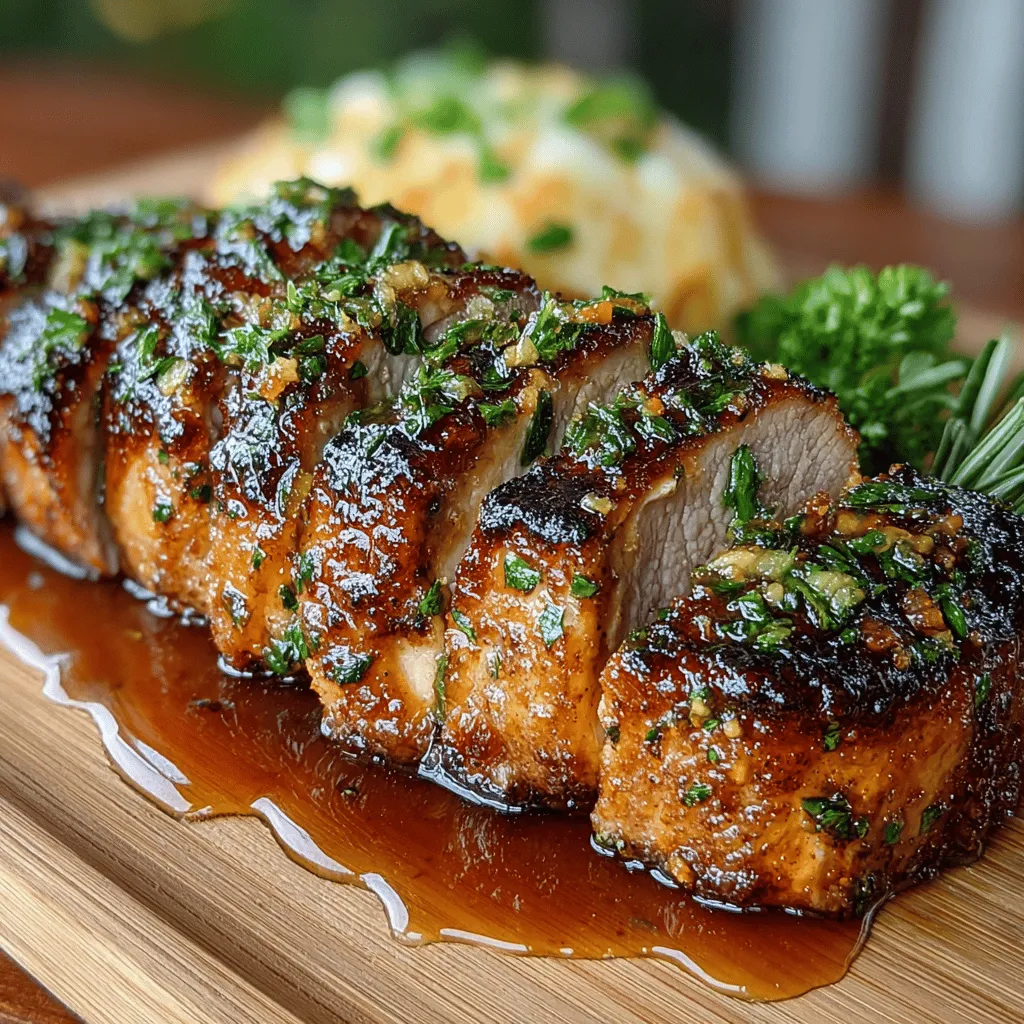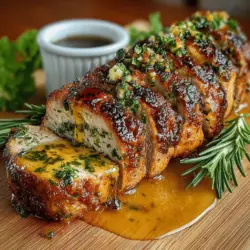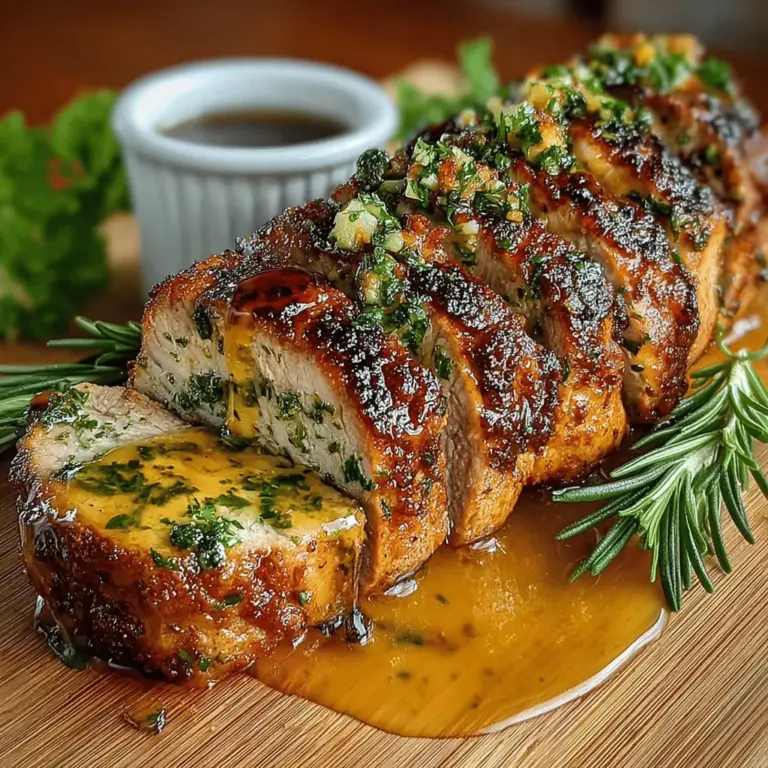Garlic Herb Roasted Pork Tenderloin with a Twist: A Flavorful Introduction
Pork tenderloin is a culinary gem often celebrated for its remarkable tenderness and versatility, making it a popular choice for both weeknight dinners and special occasions. This lean cut of meat is not only easy to cook but also absorbs flavors beautifully, making it a perfect canvas for a variety of seasonings and marinades. In this article, we will explore a delightful recipe for Garlic Herb Roasted Pork Tenderloin with a Twist, infusing the meat with aromatic herbs and zesty lemon. This dish promises to be a showstopper at your dinner table, combining simplicity with rich flavors that will leave your guests asking for seconds.
The journey into this savory recipe begins with understanding the characteristics of pork tenderloin, its nutritional benefits, and why it is a fantastic choice for home cooks. With the right preparation and cooking techniques, you can elevate this dish from a simple meal to a gourmet experience.
Understanding Pork Tenderloin
The Basics of Pork Tenderloin
Pork tenderloin is a long, thin cut of meat that runs along the backbone of the pig. Known for its mild flavor and delicate texture, it is one of the most tender cuts of pork available. Unlike tougher cuts that require longer cooking times, pork tenderloin cooks relatively quickly, usually taking only 20 to 30 minutes in the oven, which makes it an ideal choice for busy weeknights or impromptu dinner parties.
Nutritionally, pork tenderloin is a lean protein source, low in fat yet high in essential nutrients like B vitamins, zinc, and phosphorus. A 3-ounce serving typically contains about 120 calories and 22 grams of protein, making it a healthy option for those looking to maintain a balanced diet without sacrificing flavor.
Why It’s a Great Choice for Home Cooks
For home cooks, pork tenderloin presents an array of benefits. Its adaptability allows it to pair well with various flavor profiles—from sweet and tangy to savory and herby. Additionally, pork tenderloin is forgiving; it can be roasted, grilled, or sautéed, making it a versatile option in the kitchen. With its quick cooking time and minimal preparation, it’s perfect for both novice cooks and seasoned chefs looking to impress without spending hours in the kitchen.
Selection and Preparation
How to Choose the Best Pork Tenderloin
Selecting the right pork tenderloin is crucial for achieving the best flavor and texture. When shopping, look for a cut that is pink to light red in color with a small amount of marbling and a relatively even shape. Avoid any that appear discolored or have excessive fat, as these can lead to an unpleasant texture and flavor. If possible, opt for pork that is labeled as “humanely raised” or “organic,” which often indicates better quality.
Tips for Trimming and Cleaning the Meat
Before cooking, it’s essential to properly trim and clean the pork tenderloin. Start by removing any silver skin—a tough, silvery membrane that can be found on one side of the tenderloin. Using a sharp knife, carefully slide the blade underneath the silver skin and pull it away from the meat. This will ensure that the tenderloin cooks evenly and absorbs the marinade more effectively. Rinse the meat under cold water, pat it dry with paper towels, and it’s ready for seasoning.
Importance of Marinating for Flavor and Tenderness
Marinating pork tenderloin not only enhances its flavor but also contributes to its tenderness. The acid in the marinade (such as lemon juice or vinegar) helps break down the proteins, resulting in a juicier and more flavorful piece of meat. For this recipe, we will use a vibrant herb marinade that combines garlic, fresh herbs, and lemon zest, which not only infuses the meat with flavor but also adds a refreshing brightness to the dish.
Ingredients Breakdown
Essential Ingredients
This Garlic Herb Roasted Pork Tenderloin with a Twist requires a handful of key ingredients that work harmoniously to elevate the dish. The main components include:
– Pork Tenderloin: The star of the recipe, providing a tender and juicy base.
– Garlic: Fresh garlic enhances the flavor profile, adding depth and aromatic qualities.
– Fresh Herbs: A combination of rosemary, thyme, and parsley will infuse the pork with a fragrant herbaceousness. These herbs are not only flavorful but also contribute to the overall presentation of the dish.
– Lemon: Both the juice and zest will brighten the flavors and help to tenderize the meat, creating a perfect balance of zestiness and richness.
For those who may not have access to fresh herbs, dried alternatives can be used, but it’s important to adjust the quantities, as dried herbs are more concentrated than fresh.
Cooking Essentials
To successfully prepare this dish, you will need some essential kitchen tools:
– Oven-Safe Skillet: This is crucial for searing the pork tenderloin on the stovetop before transferring it to the oven for roasting. An oven-safe skillet, such as cast iron or stainless steel, allows for a seamless transition between cooking methods.
– Meat Thermometer: A reliable meat thermometer is essential for ensuring that the pork reaches the desired internal temperature of 145°F, resulting in perfectly cooked, juicy meat.
– Mixing Bowl: To prepare the marinade, a mixing bowl will be necessary for combining the ingredients before applying them to the meat.
Marinade Magic
Creating the Perfect Marinade
Now that we’ve covered the essential ingredients and tools, let’s dive into creating the perfect herb marinade. This step is pivotal in ensuring that your Garlic Herb Roasted Pork Tenderloin is packed with flavor.
1. Combine Ingredients: In a mixing bowl, start by mincing 4-5 cloves of fresh garlic and adding them to the bowl. Next, chop your choice of fresh herbs—about 2 tablespoons each of rosemary and thyme, and 1 tablespoon of parsley. Add the zest of one lemon, along with the juice from that lemon, to the bowl.
2. Add Olive Oil and Seasoning: Pour in approximately ¼ cup of extra virgin olive oil, which will help carry the flavors and create a nice crust during cooking. Season generously with salt and pepper to taste, as these will enhance the overall flavor of the pork.
3. Mix and Marinate: Whisk the ingredients together until well combined. Place the pork tenderloin in a resealable plastic bag or a shallow dish, then pour the marinade over the meat, ensuring it is well-coated. Seal the bag or cover the dish and refrigerate. For optimal flavor, allow the pork to marinate for at least 2 hours, or overnight if time permits.
The Science Behind Marinating Meat
Marinating meat serves several purposes. The acid in the marinade not only acts as a tenderizer but also helps to infuse flavor deep into the meat. Additionally, the oil in the marinade aids in moisture retention during cooking, preventing the pork from drying out. As the tenderloin absorbs the marinade, it undergoes a chemical transformation that enhances its juiciness and flavor profile.
Benefits of Marinating Overnight vs. Shorter Durations
While marinating for a couple of hours can impart good flavor, marinating overnight allows the flavors to penetrate even deeper, resulting in a more robust taste. However, it’s essential to balance the marinating time; too long in an acidic marinade can lead to a mushy texture. For pork tenderloin, marinating for 8 to 12 hours is ideal to achieve the perfect balance of flavor and texture.
With the marinade prepared and the pork tenderloin resting in its flavorful bath, you are well on your way to creating a memorable dish that will impress anyone lucky enough to sit at your dinner table. In the next section, we will explore the cooking process, providing a detailed guide on how to roast the pork to perfection, ensuring every bite is succulent and bursting with flavor. Stay tuned for the delicious continuation of this culinary adventure.

Cooking Techniques
Searing the Pork Tenderloin
Searing is a crucial step in the cooking process that significantly enhances the flavor of the pork tenderloin. When you sear the meat, the high heat creates a Maillard reaction, resulting in a beautiful golden crust that locks in juices and adds depth to the overall flavor profile.
Importance of Searing for Flavor Development
The primary purpose of searing is to develop a rich, caramelized crust on the exterior of the pork tenderloin. This not only improves the taste but also adds an appealing texture. When you cut into the tenderloin after roasting, the contrast between the crispy exterior and the tender, juicy interior is remarkable.
Tips for Achieving the Perfect Golden Crust
1. Preheat Your Pan: Ensure your skillet or frying pan is hot before adding the pork. This can be tested by sprinkling a few drops of water into the pan; if they sizzle and evaporate immediately, it’s ready.
2. Use the Right Fat: Opt for oils with a high smoke point, such as canola or avocado oil, which can withstand the high heat needed for searing without burning.
3. Pat Dry: Make sure the tenderloin is thoroughly dried with paper towels before searing. Moisture can cause the meat to steam rather than sear, hindering that desired crust.
4. Avoid Overcrowding: If you’re cooking more than one tenderloin, ensure there’s enough space in the pan. Overcrowding lowers the pan temperature and prevents proper searing.
How to Avoid Common Mistakes When Searing
– Don’t Move the Meat: Once you place the tenderloin in the hot pan, resist the urge to move it around. Let it sit undisturbed for a few minutes to allow the crust to form.
– Use a Meat Thermometer: As you sear, keep an eye on the pork’s internal temperature. Ideally, it should reach 145°F (63°C) before you take it out of the pan.
Roasting to Perfection
After searing, the next step is roasting, which allows the pork to cook evenly and thoroughly. This method of cooking is essential for achieving the perfect internal temperature, ensuring the meat is safe to eat while retaining its juiciness.
The Significance of Roasting and Achieving the Right Internal Temperature
Roasting in the oven helps to finish cooking the pork tenderloin uniformly. It’s important to keep in mind that the tenderloin will continue to cook slightly after being removed from the oven due to residual heat, a phenomenon known as carryover cooking.
Using a Meat Thermometer for Accuracy
A digital meat thermometer is an invaluable tool in the kitchen. Insert the thermometer probe into the thickest part of the tenderloin, avoiding any bones or fat, to get an accurate reading.
How to Know When the Pork is Perfectly Cooked
The ideal internal temperature for pork tenderloin is 145°F (63°C). At this temperature, the pork is juicy and slightly pink in the center. Allow it to rest for at least three minutes before slicing to ensure that the juices redistribute throughout the meat.
Resting and Serving the Pork
The Resting Period
Resting is often overlooked but is essential for achieving the best texture and flavor in your pork tenderloin. Allowing the meat to rest after cooking ensures it retains its moisture.
Why Resting Meat Is Crucial for Juiciness
During cooking, the juices within the meat are driven towards the center. Resting allows these juices to redistribute throughout the pork tenderloin, resulting in a tender and succulent slice.
How to Properly Rest Pork Tenderloin
After removing the pork from the oven, transfer it to a cutting board and loosely cover it with aluminum foil. Let it rest for about 5 to 10 minutes. This short time will make a significant difference in your final dish.
Presentation Ideas
The way you present the pork tenderloin can elevate your dining experience.
Techniques for Slicing Pork Tenderloin Beautifully
When it’s time to slice the tenderloin, use a sharp knife and cut against the grain. This technique will ensure each piece is tender and easy to chew. Aim for slices about half an inch thick for a visually appealing presentation.
Garnishing with Parsley or Other Herbs
Garnishing not only adds a pop of color but also enhances the flavor. A sprinkle of freshly chopped parsley or rosemary can brighten the dish and provide a fresh contrast to the rich flavors of the pork.
Serving Suggestions to Elevate the Meal
Serve the sliced pork tenderloin on a platter with the garlic herb sauce drizzled over the top. Pair it with vibrant side dishes such as roasted seasonal vegetables or a light salad to create a well-rounded meal.
Pairing Suggestions
Complementary Side Dishes
When planning your meal, consider side dishes that will complement the flavors of the garlic herb roasted pork tenderloin.
Ideas for Sides That Pair Well with the Pork Tenderloin
– Roasted Vegetables: Seasonal vegetables such as carrots, Brussels sprouts, and sweet potatoes roasted with olive oil, salt, and pepper make a perfect accompaniment.
– Garlic Mashed Potatoes: Creamy mashed potatoes infused with roasted garlic add a rich, comforting element to your meal.
– Quinoa Salad: A light quinoa salad with fresh vegetables, herbs, and a lemon vinaigrette provides a refreshing contrast to the savory pork.
Suggestions for Roasted Vegetables and Salads
You can toss your vegetables in olive oil, garlic, and herbs before roasting to impart additional flavor. For salads, consider using a mix of greens, nuts, and a tangy dressing to balance the richness of the pork.
How to Create a Balanced Meal
Aim for a mix of textures and flavors: rich and savory pork, crisp vegetables, and a light salad or grain. This balance will keep your meal interesting and satisfying.
Conclusion
Garlic Herb Roasted Pork Tenderloin with a Twist is not just a recipe; it’s a culinary experience that showcases the beauty of simple ingredients transformed into a flavorful dish. By mastering the techniques shared in this article, you can create a meal that is not only delicious but also visually appealing. This dish is perfect for family gatherings, dinner parties, or a cozy night in. With its combination of herbs, citrus, and succulent pork, this recipe will surely become a favorite in your cooking repertoire.
Remember, the key to a successful meal lies in the details—from the careful searing of the pork to the thoughtful presentation on the plate. So gather your ingredients, invite your loved ones, and delight in the joyful cooking experience that awaits you. Enjoy your delicious Garlic Herb Roasted Pork Tenderloin!

